 W
WAlba Iulia is a city that serves as the seat of Alba County in the west-central part of Romania. Located on the Mureș River in the historical region of Transylvania, it has a population of 63,536.
 W
WAlexandria is the capital city of the Teleorman County, Muntenia, Romania. It is located south-west of Bucharest, towards the Bulgarian border. The city is situated on the Vedea River and has over 45,000 inhabitants.
 W
WArad is the capital city of Arad County, situated in the regions of Crișana and Banat, both of which are sometimes considered parts of Transylvania. It is the third largest city in Western Romania, behind Timișoara and Oradea, and the 12th largest in Romania, with a population of 159,704.
 W
WBacău is the main city in Bacău County, Romania. At the 2016 national estimation it had a population of 196,883, making it the 12th largest city in Romania. The city is situated in the historical region of Moldavia, at the foothills of the Carpathian Mountains, and on the Bistrița River. The Ghimeș Pass links Bacău to the region of Transylvania.
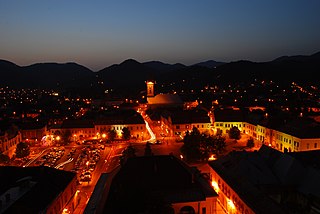 W
WBaia Mare is a municipality along the Săsar River, in northwestern Romania; it is the capital of Maramureș County. The city lies in the region of Maramureș, a subregion of Transylvania. It is situated about 600 kilometres from Bucharest, 70 km (43 mi) from the border with Hungary, and 50 km (31 mi) from the border with Ukraine.
 W
WBistrița is the capital city of Bistrița-Năsăud County, in northern Transylvania, Romania. It is situated on the Bistrița river. The city has a population of approximately 70,000 inhabitants and administers six villages: Ghinda, Sărata, Sigmir, Slătinița, Unirea and Viișoara.
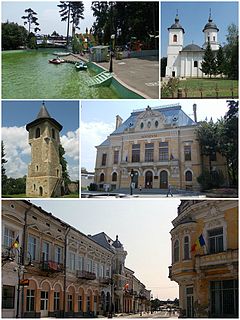 W
WBotoșani is the capital city of Botoșani County, in the northern part of Moldavia, Romania. Today, it is best known as the birthplace of many celebrated Romanians, including Mihai Eminescu, Nicolae Iorga and Grigore Antipa.
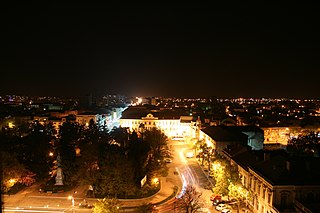 W
WBrăila is a city in Muntenia, eastern Romania, a port on the Danube and the capital of Brăila County. The Sud-Est Regional Development Agency is located in Brăila.
 W
WBrașov is a city in Transylvania, Romania and the administrative centre of Brașov County.
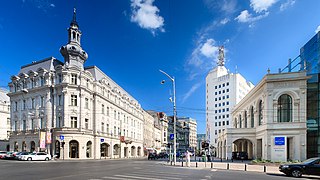 W
WBucharest is the capital and largest city of Romania, as well as its cultural, industrial, and financial centre. It is located in the southeast of the country, at 44°25′57″N 26°06′14″E, on the banks of the Dâmbovița River, less than 60 km (37.3 mi) north of the Danube River and the Bulgarian border.
 W
WThe city of Buzău is the county seat of Buzău County, Romania, in the historical region of Muntenia. It lies near the right bank of the Buzău River, between the south-eastern curvature of the Carpathian Mountains and the lowlands of Bărăgan Plain.
 W
WCălărași, the capital of Călărași County in the Muntenia region, is situated in south-east Romania, on the bank of Danube's Borcea branch, at about 12 kilometres from the Bulgarian border and 125 kilometres from Bucharest.
 W
WCluj-Napoca, commonly known as Cluj, is the fourth-most populous city in Romania. It is the seat of Cluj County in the northwestern part of the country. Geographically, it is roughly equidistant from Bucharest, Budapest and Belgrade. Located in the Someșul Mic river valley, the city is considered the unofficial capital to the historical province of Transylvania. From 1790 to 1848 and from 1861 to 1867, it was the official capital of the Grand Principality of Transylvania.
 W
WConstanța, historically known as Tomis, is the oldest continuously inhabited city in Romania. It was founded around 600 BC. The city is located in the Northern Dobruja region of Romania, on the Black Sea coast. It is the capital of Constanța County and the largest city in the historical region of Dobrogea.
 W
WCraiova, is Romania's 6th largest city and capital of Dolj County, and situated near the east bank of the river Jiu in central Oltenia. It is a longstanding political center, and is located at approximately equal distances from the Southern Carpathians (north) and the River Danube (south). Craiova is the chief commercial city west of Bucharest and the most important city of Oltenia. The city prospered as a regional trading centre despite an earthquake in 1790, a plague in 1795, and a Turkish assault in 1802 during which it was burned.
 W
WDeva is a city in Romania, in the historical region of Transylvania, on the left bank of the Mureș River. It is the capital of Hunedoara County.
 W
WDrobeta-Turnu Severin, colloquially Severin, is a city in Mehedinți County, Oltenia, Romania, on the northern bank of the Danube, close to the Iron Gates.
 W
WFocșani is the capital city of Vrancea County in Romania on the banks the river Milcov, in the historical region of Moldavia. It has a population of 79,315.
 W
WGalați is the capital city of Galați County, in the historical region of Western Moldavia, in eastern Romania. Galați is a port town on the Danube River. It has been the only port for the most part of Moldavia's existence. In 2011, the Romanian census recorded 249,432 residents, making it the 8th most populous city in Romania. Galați is an economic centre based around the port of Galați, the naval shipyard, and the largest steel mill in Romania, Galați steel works.
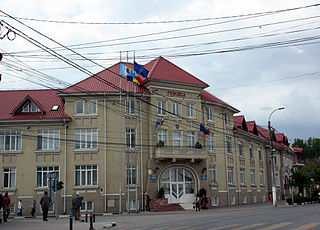 W
WGiurgiu is a city in southern Romania. The seat of Giurgiu County, it lies in the historical region of Muntenia. It is situated amongst mud-flats and marshes on the left bank of the Danube facing the Bulgarian city of Ruse on the opposite bank. Three small islands face the city, and a larger one shelters its port, Smarda. The rich grain-growing land to the north is traversed by a railway to Bucharest, the first line opened in Romania, which was built in 1869 and afterwards extended to Smarda. Giurgiu exports timber, grain, salt and petroleum, and imports coal, iron, and textiles.
 W
WIași, also referred to mostly historically as Jassy, is the second largest city in Romania and the seat of Iași County. Located in the historical region of Moldavia, it has traditionally been one of the leading centres of Romanian social, cultural, academic and artistic life. The city was the capital of the Principality of Moldavia from 1564 to 1859, then of the United Principalities from 1859 to 1862, and the capital of Romania from 1916 to 1918.
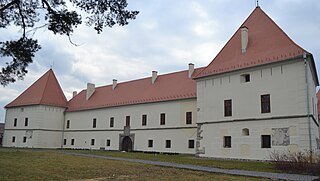 W
WMiercurea Ciuc is the county seat of Harghita County, Romania. It lies in the Székely Land, a mainly Hungarian-speaking ethno-cultural region in eastern Transylvania, and is situated in the Olt River valley.
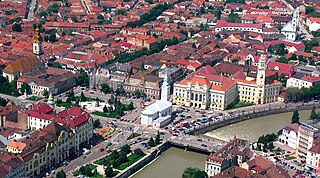 W
WOradea is a city in Romania, located in Crișana, a sub-region of Transylvania. Seat of the Bihor county, Oradea is one of the most important economic, social and cultural centers in the western part of Romania. The city is located in the north-west of the country, nestled between hills on the Crișana plain, on the banks of the river Crișul Repede, that divides the city into almost equal halves.
 W
WPiatra Neamț is the capital city of Neamț County, in the historical region of Western Moldavia, in northeastern Romania. Because of its privileged location in the Eastern Carpathian mountains, it is considered one of the most picturesque cities in Romania. The Nord-Est Regional Development Agency is located in Piatra Neamț.
 W
WPitești is a city in Romania, located on the river Argeș. The capital and largest city of Argeș County, it is an important commercial and industrial center, as well as the home of two universities. Pitești is situated in the historical region of Muntenia. It lies on the A1 freeway connecting the city directly to the national capital Bucharest, being an important railway junction, with a classification yard in nearby Bălilești. The city houses the Arpechim oil refinery, and is a marketing center for the automotive industry, in particular, Automobile Dacia.
 W
WPloiești, formerly spelled Ploești, is a city and county seat in Prahova County, Romania.
 W
WRâmnicu Vâlcea is the capital city of Vâlcea County, Romania.
 W
WReșița is a city in western Romania and the capital of Caraș-Severin County. It is located in the Banat region, broadly considered part of Transylvania. The city had a population of 73,282 in 2011.
 W
WSatu Mare is a city with a population of 102,400 (2011). It is the capital of Satu Mare County, Romania, as well as the centre of the Satu Mare metropolitan area. It lies in the region of Maramureș, broadly part of Transylvania. Mentioned in the Gesta Hungarorum as castrum Zotmar, the city has a history going back to the Middle Ages. Today, it is an academic, cultural, industrial, and business centre in the Nord-Vest development region.
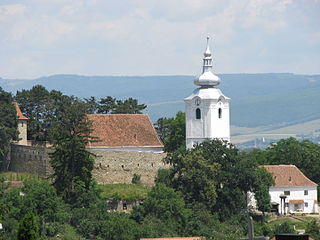 W
WSfântu Gheorghe is the capital city of Covasna County, Romania. Located in the central part of the country and in the historical region of Transylvania, it lies on the Olt River in a valley between the Baraolt Mountains and Bodoc Mountains. The city administers two villages, Chilieni (Kilyén) and Coșeni (Szotyor).
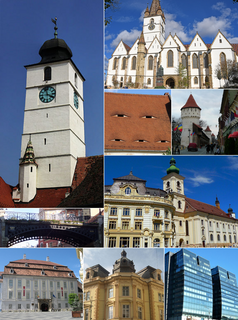 W
WSibiu is a city in Transylvania, a historical region of Romania. Located some 275 km (171 mi) north-west of Bucharest, the city straddles the Cibin River, a tributary of the river Olt. Now the capital of the Sibiu County, between 1692 and 1791 and 1849–65 Sibiu was also the capital of the Principality of Transylvania.
 W
WSlatina is the capital city of Olt County, Romania, on the river Olt. It is located in the south of Romania, on the eastern side of the river Olt, in the historical region of Muntenia. The population was 70,293 in 2011; the urban area has around 85,000 inhabitants. It is an important industrial center.
 W
WSlobozia is the capital city of Ialomița County, Muntenia, Romania, with a population of 48,241 in 2011.
 W
WSuceava is the largest city and the seat of Suceava County, situated in the historical region of Bukovina, north-eastern Romania, and at the crossroads of Central and Eastern Europe. During the late Middle Ages, from 1388 to 1564, the city was the capital of the Principality of Moldavia.
 W
WTârgoviște is a city in the region of Muntenia, Romania, and the county seat of the Dâmbovița County. It is situated on the right bank of the Ialomița. At the 2011 census Târgoviște had a population of 79,610, making it the 26th largest city in Romania. One of the most important cities in the history of Wallachia, it was its capital between the early 15th century and the 16th century.
 W
WTârgu Jiu is the capital of Gorj County in the Oltenia region of Romania. It is situated on the Southern Sub-Carpathians, on the banks of the river Jiu. Eight localities are administered by the city: Bârsești, Drăgoieni, Iezureni, Polata, Preajba Mare, Romanești, Slobozia and Ursați.
 W
WTârgu Mureș is the seat of Mureș County in the historical region of Transylvania, Romania. It is the 16th largest Romanian city, with 134,290 inhabitants as of the 2011 census. It lies on the Mureș River, the second longest river in Romania.
 W
WTimișoara is the capital city of Timiș County and the main economic, social and cultural center in western Romania. Located on the Bega River, Timișoara is considered the informal capital city of the historical Banat, which is nowadays broadly considered a subregion of Transylvania. From 1848 to 1860 it was the capital of the Serbian Vojvodina and the Voivodeship of Serbia and Banat of Temeschwar.
 W
WTulcea is a city in Northern Dobruja, Romania. It is the administrative center of Tulcea County, and had a population of 73,707 as of 2011. One village, Tudor Vladimirescu, is administered by the city.
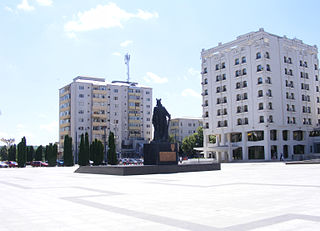 W
WVaslui, a city in eastern Romania, is the seat of Vaslui County, in the historical region of Western Moldavia. The city administers five villages: Bahnari, Brodoc, Moara Grecilor, Rediu, and Viișoara.
 W
WZalău is the seat of Sălaj County, Romania. In 2011, its estimated population was 56,202.